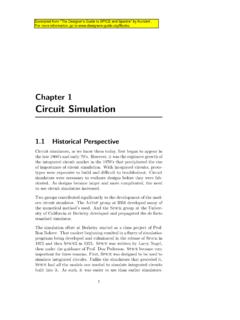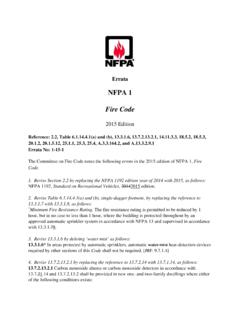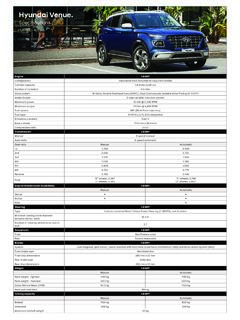Transcription of Lecture 10: Folded-Cascode Amplifiers Current Mirror Op Amps
1 1EE 435 Lecture 10: Folded-Cascode AmplifiersCurrent Mirror Op Amps2 Basic Op Amp Design Fundamental Amplifier Design Issues Single-Stage Low Gain Op Amps Single-Stage High Gain Op Amps Other Basic Gain Enhancement Approaches Two-Stage Op AmpWhere we are at:3M1M3-AVINVOUTHigh output impedance quarter-circuitsRegulated Cascode Amplifieror Gain Boosted Cascode Quarter Circuit A is usually a simple amplifier, often the reference op amp with + terminal connected to the desired quiescent voltage Assume biased with a dc Current source (not shown) at drain of M3 Reviewfrom last Lecture :4 Gain-Boosted telescopic Cascode Op AmpVDDVOUTCLVB2VB3 VSSVB5M11A1A2A3A4 ITVINVINM1M2M3M4M5M7M6M8 Advantages:Significant increase in dc gainLimitations:: Signal swing (4 VDSAT+VTbetween VDDand VSS) Reduction in GB power efficiency-some Current required to bias A Amplifiers -additional pole in A amplifier -may add requirements for some compensation Area Overhead for 4 transistors and 4 Amplifiers -actually minor concern since performance will usually justify these resources(with or w/o Current Mirror counterpart circuits)Reviewfrom last Lecture :5 Are there other useful high output impedance circuits that can be used for the quarter circuit?
2 V1GM1V1G1V1GM1G1G2CL2 VdVo++ 101212122 MVLMLGAGGGGBWCGGBC Reviewfrom last Lecture :6 Implementation of Biased Folded Cascode Amplifier?VDDVINM1M3M5VB1VB3 Biased Folded CascodeImplementation of Biased Folded CascodeVDDVINM1M3VB1IB1IB2 VOUTVSSR eviewfrom last Lecture :7 VDDVINM1M3M5VB1VB3 Analysis of Biased Folded Cascodego1gM1V1V1go3gM3V3V3go5gM5V5V5 CLVOUTVINVX 0 OUTmOUTo3Lm33X o3Xo1o3o5m1 1m33 OUT o33X1 INOUTo3Lm3o33m1 IN3m3o1o3o5 OUT o1o3 INLo1om335 VgsCg VV gV gggg V g VVgVVVVVgsCggVg VV g +ggg+VVggVsCgggg GMGOHow can this be seen by inspection? First observe if all go s are 0, GM=gm1 Then observe M3 cascodes the impedance g01+go58 Biased Folded Cascode Quarter CircuitVDDVINM1M3M5VB1VB2 CLVOUT OUTm1o3 INLo1o5m3 VggVsCggg m3m1V0o1o5o3ggAggg m1 LgGBC 9 Basic Amplifier Structure Comparisons(ideal Current source biasing)Common SourceCascodeRegulated CascodeFolded CascodeSmall Signal Parameter Domain m3m1V0o1o5o3ggAggg mV0ogAg m3m1V0o1o3ggAgg m3m1V0o1o3ggAAgg mLgGBC mLgGBC mLgGBC mLgGBC 10 Basic Amplifier Structure Comparisons EB3EB131 VOVV1 4A EB3EB1351 VOVV 4 ACommon SourceCascodeRegulated CascodeFolded Cascode EBVOV1 2A EBLDDV1CV2 PGBP ractical Parameter Domain EB1 LDDV1CV2 PGB EB3EB131 VOVVA 4A EB1 LDDV -1CV2 PGB =pct power in A EB1 LDDV CV2 PGB =fraction of Current of M5that is in M111 Biased Folded-Cascode AmplifierVDDVINM1M3M5VB1VB3 Quarter CircuitM2M4M6VB4VB2 VSSC ounterpart Circuit12 QUARTER CIRCUITF olded-Cascode Operational AmplifierOp AmpVDDVDDVB1VB2VB5 VSSVSSVSSVDDVOUTVOUTVB1 VINVINVB2VB5 ITVB3VB4 VDDVINVB1VB313 Folded-Cascode Operational Amplifier (redrawn)
3 These transistors pair-wise form a Current source and one in each pair can be removedVB5 VINVINVOUTVOUTVDDVSSVSSITVB4VB3VB2VB1M1M 2M7M9M8M10M5M6M3M4M11M12 VDDVB5IT214 Folded Cascode Op Amp Needs CMFB Circuit for VB4 Either single-ended or differential outputs Can connect counterpart as Current Mirror to eliminate CMFB folding caused modest deterioration of AV0and GB energy efficiency Modest improvement in output swingVINVINVOUTVOUTVDDVSSVSSITVB4VB3VB2V B1M1M2M7M9M8M10M5M6M3M4IT215 Folded Cascode Op Amp(Single-ended Output)VINVINVDDVSSVSSITVB3VB2M1M2M7M9M8 M10M5M6M3M4 VOUTCLIT2VB11mmEQgg OEQLmEQVgsCgsA m9O9O7m3O3O5O1 OEQgggggggg LmCgGB1 LmEQCgGB OEQmEQVggA 0 m9O9O7m3O3O5O1mV0ggggggggA 116 Operational Amplifier Structure ComparisonReference Op AmpTelescopic CascodeRegulated CascodeFolded Cascode31121 OOmVOgggA LmCgGB21 Small Signal Parameter DomainLTCISR2 LTCISR2 m5o5o7m3o3o1m1ogggggg2gA LmCgGB21 3m9o9o71m3o3o1m1oAgggAggg2gA LmCgGB21 LTCISR2 m9o9o7m3o3o5o1m1oggggggg2gA LmCgGB21 LTCISR2 17 Operational Amplifier Structure Comparison 3EB7751EB331EB1V0AV AV V2A EB1 LDDV1C2V -1 PGB LDDC2V -1 PSR Reference Op AmpTelescopic CascodeRegulated CascodeFolded CascodePractical Parameter Domain EB131V0V1 1A EB1 LDDV1C2 VPGBLDDC2 VPSR LDDC2 VPSR EB575EB331EB1V0V V V2A EB1 LDDV1C2 VPGB =pct power in A EB979EB3351EB1V0V 1V V2 A EB1 LDDV C2 VPGBLDDC2VP SR =fraction of Current of M5that is in M118 Folded Cascode Op Amp(Single-ended Output)
4 LmCgGB1 m9O9O7m3O3O5O1mV0ggggggggA 1 What is a practical design parameter set?How many degrees of freedom are there?DOF ? {IT,W1/L1,W5/L5,W3/L3,W9/L9,W7/L7,VB1,VB 2,VB3}9 DOFP ractical Design Parameters{P, ,VEB1,VEB3,VEB5,VEB7,VEB9,VB2,VB3}where =IT/(IT+IT2)VINVINVDDVSSVSSITVB3VB2M1M2M 7M9M8M10M5M6M3M4 VOUTCLIT2VB119 Textbook reference:Some of the material we have been discussing appears in Chapter 3, some in Chapter 5, and some in Chapter 6 of the Martin and Johns textIn particular, the telescopic and folded cascode structures are referred to as advanced op amps and appear in later chapters of the text20 Folded Gain-boosted Cascode Amplifier with ideal Current source bias modest improvement in output swingLm12 CgGB m3o3o1m1ogAgggA IB1M1M3 VOUTIB2 VIN-A21 Folded Gain-boosted Cascode Amplifier-AVDDVINM1M3M5VB2 CLVOUTIBIAS AggggsCgVVm3o3o5o1Lm1 INOUT modest improvement in output swingLm1 CgGB o3o5o1m3m10gggAggA 22 Basic Amplifier Structure ComparisonsLm1 CgGB o3m3O1m1 VOggggA Common SourceCascodeRegulated CascodeFolded CascodeFolded Regulated CascodeOmVOggA LmCgGB Small Signal Parameter DomainAggggAo3m3O1m1VO Lm1 CgGB o3m3O5O1m1 VOgggggA Lm1 CgGB AgggggAo3m3O5O1m1VO Lm1 CgGB 23 Basic Amplifier Structure Comparisons EB3EB131 VOVV1 4A EB3EB1351 VOVV 4 A EB1 LDDV CV2 PGBC ommon SourceCascodeRegulated CascodeFolded CascodeFolded Regulated Cascode EBVOV1 2A EBLDDV1CV2 PGBP ractical Parameter Domain EB1 LDDV1CV2 PGB EB3EB131 VOVVA 4A
5 EB1 LDDV -1CV2 PGB =pct power in A =fraction of Current of M5that is in M1 EB3EB135122 VOVV A4 A EB112 LDDV -1 CV2 PGB 1=pct of total power in A 2=fraction of Current of M5that is in M124 Folded Gain-boosted telescopic Cascode Op Amp Needs CMFB Circuit for VB4 Either single-ended or differential outputs Can connect counterpart as Current Mirror to eliminate CMFB folding caused modest deterioration in GB efficiency and gain Modest improvement in output swingLm12 CgGB m91o9o7m33o3O5O1m1ogAgggAggg2gA VINVINVDDVSSITVB4M1M2M7M9M10M5M6M3M4 VOUTCLVINVB2VB3 VSSIT2M8VB1A1A2A3A425 Operational Amplifier Structure ComparisonReference Op AmpTelescopic CascodeRegulated CascodeFolded CascodeFolded Regulated Cascode31121 OOmVOgggA LmCgGB21 Small Signal Parameter DomainLTCISR2 LTCISR2 m5o5o7m3o3o1m1ogggggg2gA LmCgGB21 3m9o9o71m3o3o1m1oAgggAggg2gA LmCgGB21 LTCISR2 m9o9o7m3o3o5o1m1oggggggg2gA LmCgGB21 LTCISR2 9m9o9o73m3o3o5o1m1oAgggAgggg2gA LmCgGB21 LTCISR2 26 Summary of Folded Amplifier Performance +Modest improvement in output signal swing (from 5 VDS SATto 4 VDS SAT) + Can directly feed output back to input to create buffer -Deterioration in AV0 (maybe 30% or more) -Deterioration in GB power efficiency (can be significant) -Minor increase in circuit size27 Other Methods of Gain EnhancementOCCOQCQCMVgggA 0 LmQCCgGB Two denominator of numerator of AV0 Previous approaches focused on decreasing denominatorConsider now increasing numeratorRecall.
6 VINVDDVSSVOUTQ uarter CircuitCounterpart CircuitCLVBB28 Determination of op amp characteristics from quarter circuit characteristicsM1 OVdL12GV2 AVsCGG FVINIXXVOUTVSSCLS mall signal differential amplifierGsCGsALMVQC )(Small signal Quarter CircuitFPVDDVBB OUT V OUT Vd2V d2 V IBIASCLCLor VSS Note that the counterpart circuit is simply serving as the biasing Current source Could use counterpart circuits (or other circuits) from other quarter circuits for P Counterpart circuits connected as one-port Can think of making differential op amp directly from quarter circuit29 Differential input op amp directly from quarter circuit M1 OVdL12GV2 AVsCGG FVINIXXVOUTVSSCLGsCGsALMVQC )(FPVDDVBB OUT V OUT Vd2V d2 V IBIASCLCLor VSSBBM1 OVdL1 IGV2 AVsCGG FVDDIBB OUT V OUT Vd2V d2 V CLCLVSSIBBFVDDIBB OUT V OUT Vd2V d2 V CLCLIBBIBIAS30gmEQGain Enhancement StrategyConsider using the quarter circuit itself to form the op ampgmis increased by the Mirror gain !Mggm1 MQC M11 : MIBVINVOUTCLC onsider this quarter circuitFolding is required to establish the correct bias Current directionCould have done this for other quarter circuits as well but there is a particularly important reason we are following this approach with this quartercircuit What is it ?
7 OQCgOutput conductance of QC:31gmEQGain Enhancement Strategy1 : MVINIBVOUTM1 Redraw to absorb IBin the quarter circuitBBOEQOQCOIggg MQCM1g= g M32gmEQGain Enhancement StrategyM : 1 IBM11 : MIBM2 VINVOUTVINVOUTIT1 : MVINIBVOUTM133 Current Mirror Op AmpsOEQmEQV0ggA 21mmEQgMg Premise: Transconductance gain increased by Mirror gain MPremise: If output conductance is small, gain can be very highPremise:GB very good as wellLmEQCgGB Very Simple Structure!M : 1 IBM11 : MIBM2 VINVOUTVINVOUTITCLCLS till need to generate the bias Current IBBBOEQOQCOIggg -OUTV0++ININVA=V - V(for VIN+=Vd/2)34 Current Mirror Op AmpsVDDVSSVINVINVOUTVOUTM : 11 : MITVSSVSSM1M2 VDDVSSVINVINVOUTVOUTITVB1 VSSVSSVB2M1M2M3M4M5M6M7M8M9 Need CMFB to establish VB2 Can use higher output impedance Current mirrorsCan use Current Mirror bias to eliminate CMFB but loose one outputBasic Current Mirror Op Amp35Is this a real clever solution?36 Basic Current Mirror Op Amp86 OOOEQggg VDDVSSVINVINVOUTVOUTITVB1 VSSVSSVB2M1M2M3M4M5M6M7M8M9 CLCL21mmEQgMg O8O6m1 VOgg2gMA LmCgMGB21 CMFB not shownLTCIMSR2 37 Current - Mirror Op Amp offers strategy forgmenhancement Very Simple Structure Has applications as an OTA Based upon small signal analysis, performance appears to be very good !
8 But how good are the properties of the CMOA?Is this a real clever solution? 38 Seminal Work on the PROCEEDINGSFrom:39 Seminal Work on the PROCEEDINGSD ecember 1969 From:40 VINVINQ1Q2I1I2 IABCQ3Q4I3I4 IOUT 12 ABIIMII IAIB344 OUTB3 AIIIIIII Original OTAC urrent Mirror ABOUTIIMI 41 Original OTAVINVINQ1Q2I1I2 IABCQ3Q4I3I4 IOUT 12 ABIIMII IAIB2 BMII 1 AMII ABOUTIIMI 42 Original OTA ABOUTIIMI VINVINQ1Q2I1I2 IABCQ3Q4I3I4 IOUTIAIB2 BMII 1 AMII 43 Original OTA ABOUTIIMI VINVINQ1Q2I1I2 IABCQ3Q4I3I4 IOUTIAIB2 BMII 1 AMII 3- Mirror OTA44 Current Mirror Op Amp W/O CMFBVDDVSSVINVINM : 11 : MITVSS1 : 1 VOUTIOUTVINgm1mmEQMgg Often termed an OTAINmOUTVgI Introduced by Wheatley and Whitlinger in 196945 End of Lecture 10


















